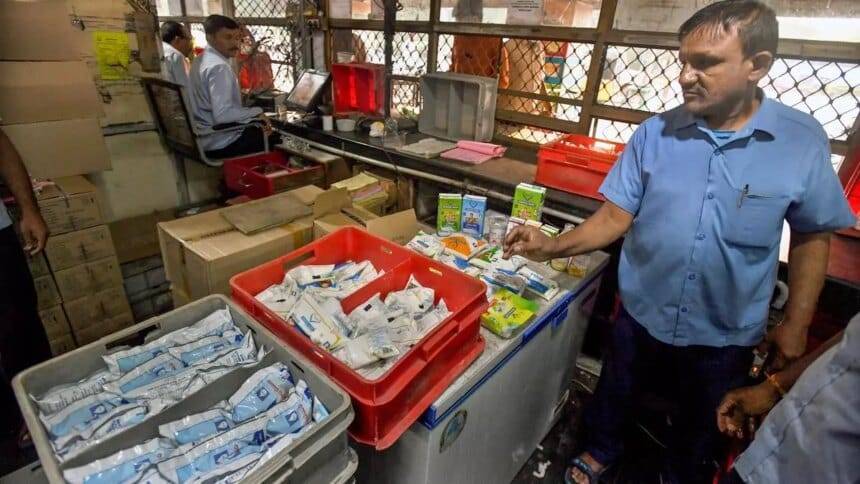Main Points of White Revolution In Hindi (मुख्य बातें – हिंदी में)
- डेयरी उद्योग की उन्नति: आजादी के बाद, भारत दूध की कमी से जूझने वाले देशों में से एक था, लेकिन श्वेत क्रांति के कारण यह दुनिया का सबसे बड़ा दूध उत्पादक और उपभोक्ता बन गया है। 2022-23 में दूध उत्पादन 230.58 मिलियन टन तक पहुंच गया, जिसमें 2023-24 में और वृद्धि की संभावना है।
- उद्योग की आर्थिक भूमिका: डेयरी क्षेत्र ने राष्ट्रीय अर्थव्यवस्था में महत्वपूर्ण स्थान प्राप्त किया है, जिससे 5% का योगदान और लगभग 80 मिलियन लोगों को रोजगार मिला है। इसके बावजूद, यह पनपती जनसंख्या और दूध की मांग में वृद्धि जैसी चुनौतियों का सामना कर रहा है।
- उत्पादकता की चुनौतियाँ: भारत का डेयरी क्षेत्र उत्पादकता के संकट का सामना कर रहा है। उदाहरण के लिए, भारतीय नस्ल की गायों की दूध उत्पादन क्षमता अन्य देशों की तुलना में काफी कम है। दूध की बढ़ती कीमतें और फ़ीड लागत में वृद्धि ने इस संकट को और गहरा किया है।
- श्वेत क्रांति 2.0 का महत्व: श्वेत क्रांति 2.0 के तहत उत्पादकता को बढ़ाने के लिए आधुनिक प्रजनन तकनीकों का उपयोग करने की आवश्यकता है। भ्रूण स्थानांतरण और लिंग-आधारित वीर्य जैसी तकनीकें मादा बछड़ों की संख्या बढ़ाने में मदद कर सकती हैं।
- संपूर्ण दृष्टिकोण की आवश्यकता: पशु पोषण में सुधार कर, उच्च गुणवत्ता वाले साइलेज का उत्पादन और सरकारी, सहकारी समितियों और निजी क्षेत्र के बीच सहकारिता को बढ़ावा देकर उत्पादकता की चुनौतियों का समाधान किया जा सकता है। इससे भारत दूध अधिशेष देश में परिवर्तित हो सकता है।
Main Points In English(मुख्य बातें – अंग्रेज़ी में)
Here are the main points derived from the article regarding India’s dairy industry and the need for a second White Revolution:
- Transformation of the Dairy Industry: Post-independence, India evolved from a nation facing milk shortages to becoming the world’s largest producer and consumer of milk. The implementation of strategic initiatives like the White Revolution significantly boosted milk production from 17 million tons in 1950-51 to 230.58 million tons in 2022-23.
- Current Challenges: Despite its achievements, the Indian dairy industry is grappling with challenges such as population growth, increased demand for protein from milk, rising production costs due to feed prices, and declining consumption due to rising milk prices.
- Productivity Issues: The industry suffers from low productivity, with average milk yield from crossbreed cows in India being only 8.52 liters per day, compared to 30 liters in the United States. This productivity gap highlights the need for urgent reforms.
- Introduction of White Revolution 2.0: India must initiate a second White Revolution to enhance productivity through modern technologies such as embryo transfer and sex-sorted semen, which can significantly improve breeding outcomes and genetic stock.
- Holistic Approach Required: Addressing the productivity puzzle extends beyond breeding technologies to include better animal nutrition. India needs to boost its feed production, as there is a significant shortfall, and implementing techniques such as silage production can help meet nutritional needs. Collaborative efforts from the government, cooperatives, and the private sector are crucial for sustaining growth in the dairy sector.
Complete News In Hindi(पूरी खबर – हिंदी में)
आजादी के बाद से भारत के डेयरी उद्योग में एक उल्लेखनीय परिवर्तन आया है, जो दूध की कमी वाले देश से दुनिया के सबसे बड़े दूध उत्पादक और उपभोक्ता के रूप में विकसित हुआ है। हालाँकि, अपनी उपलब्धियों के बावजूद, उद्योग को उन चुनौतियों का सामना करना पड़ रहा है जिनके लिए दूसरी श्वेत क्रांति की आवश्यकता है।
आजादी के बाद शुरुआती वर्षों में, भारत दूध की कमी से जूझ रहा था, आयात पर बहुत अधिक निर्भर था जबकि प्रति व्यक्ति खपत कम थी। समय के साथ, श्वेत क्रांति जैसी रणनीतिक पहलों के माध्यम से, भारत का दूध उत्पादन 1950-51 में 17 मिलियन टन (एमटी) से बढ़कर 2022-23 में प्रभावशाली 230.58 मिलियन टन हो गया। एफएओ डेयरी मार्केट रिव्यू (2023) के अनुसार, भारत का दूध उत्पादन 2023-24 में 236.35 मिलियन टन तक पहुंचने का अनुमान है, जो पिछले वर्ष की तुलना में 2.5 प्रतिशत की वृद्धि दर्शाता है, जो वैश्विक औसत विकास दर को पार कर जाएगा। इस बदलाव ने भारत को दूध उत्पादन और खपत में वैश्विक नेता की स्थिति में पहुंचा दिया।
श्वेत क्रांति ने एक महत्वपूर्ण भूमिका निभाई, जिससे प्रति दिन 126 मिलियन लीटर की प्रसंस्करण क्षमता के साथ भारत की वैश्विक दूध उत्पादन हिस्सेदारी 24 प्रतिशत से अधिक हो गई। डेयरी क्षेत्र राष्ट्रीय अर्थव्यवस्था में एक महत्वपूर्ण योगदानकर्ता के रूप में उभरा, सकल घरेलू उत्पाद का 5 प्रतिशत हिस्सा और लगभग 80 मिलियन लोगों को रोजगार मिला।
इन उपलब्धियों के बावजूद, उद्योग को गंभीर चुनौतियों का सामना करना पड़ रहा है जिन पर तत्काल ध्यान देने की आवश्यकता है। जनसंख्या वृद्धि, प्रोटीन के सबसे सार्वभौमिक उपभोग स्रोत के रूप में दूध की प्रधानता और पोषण पर बढ़ता ध्यान जैसे कारक इस वस्तु की मांग को बढ़ा रहे हैं।
उत्पादन जारी रखने के लिए संघर्ष कर रहा है।
उत्पादकता पहेली
ऐसा इसलिए है क्योंकि स्वतंत्रता के बाद के वर्षों में नाटकीय बदलाव के बावजूद, भारत का डेयरी क्षेत्र उत्पादकता की समस्या से जूझ रहा है। उदाहरण के लिए, भारत में विदेशी या संकर नस्ल की गायों की औसत दूध उपज केवल 8.52 लीटर प्रति दिन थी। इसकी तुलना में, संयुक्त राज्य अमेरिका में गायें प्रतिदिन लगभग 30 लीटर दूध का उत्पादन करती हैं।
इससे मांग-आपूर्ति का अंतर बढ़ रहा है, जो फ़ीड लागत में वृद्धि के कारण उत्पादन की बढ़ती लागत के साथ मिलकर दूध की कीमतें बढ़ा रहा है।
दूध की कीमत में वृद्धि केवल तेज हो रही है और व्यापक मुद्रास्फीति को पीछे छोड़ रही है – अकेले पिछले वर्ष में कीमतें 15 प्रतिशत बढ़ गई हैं – उद्योग को खपत में गिरावट से बचने के लिए तत्काल कार्रवाई करने की आवश्यकता है।
श्वेत क्रांति 2.0
कुंजी श्वेत क्रांति 2.0 को शुरू करने में निहित है।
ऐसा करने के लिए भारत को अपनी उत्पादकता पहेली को हल करने की आवश्यकता है।
भ्रूण स्थानांतरण और लिंग-वर्गीकृत वीर्य जैसी आधुनिक तकनीकों के माध्यम से उत्पादकता बढ़ाना महत्वपूर्ण है। ये नवाचार प्रजनन परिणामों में सुधार करते हैं, आनुवंशिक स्टॉक को बढ़ाते हैं, और मादा बछड़ों की संभावना बढ़ाते हैं, जिससे अंततः उत्पादकता बढ़ती है।
उदाहरण के लिए, भ्रूण स्थानांतरण तकनीक को गेम-चेंजर के रूप में तेजी से सराहा जा रहा है। यह हमें उच्च आनुवंशिक योग्यता वाली गायों से पैदा होने वाले बछड़ों की संख्या में वृद्धि करके बेहतर आनुवंशिक स्टॉक वाली गायों को प्रजनन करने में सक्षम बना सकता है।
लिंग-आधारित वीर्य के उपयोग से केवल मादा बछड़ों के पैदा होने की संभावना 90 प्रतिशत से अधिक हो जाती है, जबकि पारंपरिक वीर्य का उपयोग करके प्राकृतिक प्रजनन, या यहाँ तक कि कृत्रिम गर्भाधान से 50 प्रतिशत की वृद्धि होती है।
इन सभी प्रथाओं में काफी संभावनाएं हैं, लेकिन बुनियादी पहलू यह जानना है कि कोई जानवर गर्भधारण के लिए सही समय पर कब है।
जानवरों के प्रजनन चक्रों की निगरानी के लिए डिजिटल उपकरणों का लाभ उठाना – जैसे सेंसर जो किसी जानवर के शरीर के तापमान आदि की निगरानी कर सकते हैं और यह निर्धारित करने में मदद कर सकते हैं कि क्या यह गर्भधारण के लिए सही विंडो में है – गर्भाधान की सफलता दर में काफी वृद्धि हो सकती है।
वास्तव में, डिजिटलीकरण का लाभ उठाने से गर्भाधान की सफलता दर को 35-40 प्रतिशत से बढ़ाकर 70 प्रतिशत से अधिक करने की क्षमता है।
एक समग्र दृष्टिकोण
लेकिन हमें भारत की उत्पादकता पहेली को सुलझाने के लिए गर्भाधान तकनीकों से परे भी देखना होगा। वास्तव में समग्र दृष्टिकोण में बेहतर पशु पोषण भी शामिल होना चाहिए।
पशु पोषण का सीधा प्रभाव दूध की पैदावार पर पड़ता है। भारत का सीमित पोषक आहार उत्पादन – देश केवल 15 मिलियन टन फ़ीड का उत्पादन करता है जबकि इसे लगभग 70 मिलियन टन की आवश्यकता होती है – फ़ीड सुरक्षा को प्राथमिकता देने की आवश्यकता को रेखांकित करता है5.
लेकिन चारा आसानी से नहीं मिल पाता। भारत क्रमशः 11.24-32 प्रतिशत हरे चारे और 23 प्रतिशत सूखे चारे की कमी का सामना कर रहा है। 6
इस प्रकार इसे साइलेज में बदलना चाहिए।
जानवरों को सही पोषण मिले यह सुनिश्चित करने में साइलेज महत्वपूर्ण भूमिका निभा सकता है, इतना ही नहीं अमेरिकी यूएसडीए का अनुमान है कि अच्छी गुणवत्ता वाला साइलेज गाय की ऊर्जा जरूरतों का आधा हिस्सा पूरा कर सकता है।
हालाँकि, साइलेज उगाने के लिए अधिक भूमि पर खेती करने की आवश्यकता होती है, जिससे चारा उत्पादन के लिए बंजर भूमि का उपयोग करने की खोज को बढ़ावा मिलता है।
इन रणनीतियों को प्रभावी ढंग से लागू करने के लिए सरकार, सहकारी समितियों और निजी क्षेत्र से जुड़े सहयोगात्मक प्रयास महत्वपूर्ण हैं।
व्यापक दृष्टिकोण को बढ़ावा देकर और आधुनिक प्रौद्योगिकियों का लाभ उठाकर, भारत अपने डेयरी क्षेत्र में निरंतर विकास सुनिश्चित करके उत्पादकता चुनौतियों पर काबू पा सकता है। यह ठोस प्रयास भारत को अपनी डेयरी सफलता की विरासत को जारी रखते हुए, दूध-सुरक्षित राष्ट्र से दूध अधिशेष देश में बदल सकता है।
लेखक गोदरेज एग्रोवेट लिमिटेड के प्रबंध निदेशक हैं
Complete News In English(पूरी खबर – अंग्रेज़ी में)
India’s dairy industry has transformed significantly since independence, evolving from a country with milk shortages to the largest producer and consumer of milk in the world. Despite these achievements, the industry faces challenges that call for a second white revolution.
In the early years after independence, India struggled with a milk deficit and was heavily reliant on imports, with low per capita consumption. However, through strategic initiatives like the white revolution, India’s milk production surged from 17 million tons in 1950-51 to an impressive 230.58 million tons in 2022-23. According to the FAO Dairy Market Review (2023), India’s milk production is projected to reach 236.35 million tons in 2023-24, reflecting a 2.5% increase from the previous year, surpassing the global average growth rate. This rapid growth has positioned India as a global leader in milk production and consumption.


The white revolution has played a crucial role in this success, leading to a global share of over 24% in milk production, with a processing capacity of about 126 million liters per day. The dairy sector has become a significant contributor to India’s economy, accounting for 5% of the GDP and providing employment for nearly 80 million people.
However, the industry is now confronting serious challenges that require immediate attention. Factors like population growth, the rising demand for milk as a universal protein source, and an increasing emphasis on nutrition are driving demand. Despite this, production is struggling to keep pace.
A key issue is productivity. Even with substantial growth, India’s dairy sector still faces productivity challenges. For instance, hybrid cows in India average only 8.52 liters of milk per day, compared to about 30 liters per day in the United States. This gap is widening due to rising feed costs, which are contributing to higher milk prices.
Milk prices have been increasing rapidly, outpacing general inflation, with a 15% rise in the last year alone. The industry urgently needs to take action to avert a decline in consumption.
Initiating a “White Revolution 2.0” is essential. To achieve this, India must focus on solving its productivity issues. Utilizing modern technologies such as embryo transfer and sex-sorted semen can significantly enhance productivity. These innovations improve breeding outcomes, increase genetic stock, and raise the likelihood of female calf births, ultimately boosting productivity.


For example, embryo transfer technology is gaining recognition as a game-changer, enabling the production of calves from high-genetic-quality cows. The use of sex-sorted semen can increase the chances of producing female calves to over 90%, compared to a 50% likelihood with traditional semen methods. All these practices hold substantial promise, but understanding the right timing for animal breeding is crucial.
Leveraging digital tools to monitor animal reproductive cycles—such as sensors to track body temperature—can greatly enhance conception success rates. In fact, digitization could potentially raise conception success from 35-40% to over 70%.
However, addressing India’s productivity challenges requires looking beyond breeding technologies. A comprehensive approach must also include improved animal nutrition. The direct correlation between animal nutrition and milk yield is evident; India only produces 15 million tons of feed while needing approximately 70 million tons, highlighting the urgent need for feed security.
Currently, India is facing a significant shortage of both green and dry fodder (about 11.24-32% and 23%, respectively). To mitigate this, there is a need to convert more of this fodder into silage. Silage can play a crucial role in ensuring animals receive proper nutrition, as quality silage can meet half of a cow’s energy needs.
Growing silage requires more land, emphasizing the need to utilize barren land for fodder production. Collaborative efforts involving the government, cooperatives, and the private sector are essential for effectively implementing these strategies.
By promoting a holistic approach and embracing modern technologies, India can address its dairy productivity challenges and ensure sustainable growth in the sector. This concerted effort could transform India from a milk-deficient nation to one with a milk surplus, while also continuing its legacy of dairy success.
The author is the Managing Director of Godrej Agrovet Limited.








